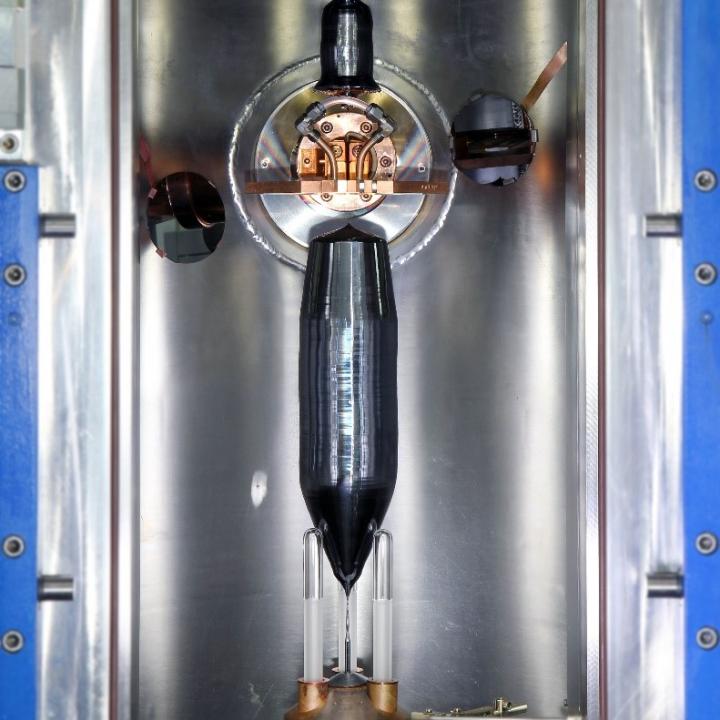Original kilogram replaced — new International System of Units (SI) entered into force

Prototype of a silicon-28 single crystal after growth in a floating zone plant in the context of the KILOGRAM project. Credit: IKZ
The new International System of Units (SI) was adopted at the 26th General Conference on Weights and Measures in Paris on 16 November 2018. Now the system officially came into force on 20 May 2019, the World Metrology Day. From now on, 7 natural constants form the foundation of all measures.
Hereafter, a new definition for the kilogram is valid using the Planck constant and thus this unit is no longer determined through the mass of the „original kilogram”. The scientific and high-technology communities mostly benefit from this.
The IKZ played a decisive role in replacing the almost 130-year-old artificial object of the original kilogram, because the structurally perfect crystals of isotopically-pure silicon-28 (Si-28, enrichment up to 99.9995 %) grown at the IKZ were of decisive importance for this project.
In these crystals, almost all the atoms have the same mass and are arranged in a regular three-dimensional lattice, which makes a very exact assignment possible between the mass of the crystal and the number of its atoms.
From this relation, the value of the Avogadro constant could be derived with unprecedented precision and thus used as a fundamental natural constant for the definition of the kilogram, since the Plank constant could be determined more precisely with the help of the Avogadro constant.
In the new SI system, the value of the Avogadro constant is determined and one mole therefore contains exactly 6.02214076×10 to the power of 23 individual particles.
But that is not everything. Now all 7 basic units are defined by natural constants. This has been the case for many years for the second (with the hyperfine structure transition of the ground state in the Cs atom), the metre (via the speed of light) and the candela (via the photometric radiation equivalent of a special radiation).
Now the other units also follow, whereby here the elementary charge (for the ampere), the Boltzmann constant (for the Kelvin), the Avogadro constant (for the mole) and the Planck constant (for the kilogram) play the decisive roles.
Within the framework of the “KILOGRAM” projects led by the Physikalisch-Technische Bundesanstalt (PTB) in Braunschweig, several very precise spheres with shape deviations of less than 20 nm at a diameter of about 94 mm and with a defect-free polished surface were prepared from the silicon-28 crystals grown at IKZ using the float-zone method (FZ).
Under these preconditions, PTB succeeded in determining the number of silicon-28 atoms in a crystal sphere of 1 kilogram total mass, with the required uncertainty of less than 2 x 10 to the power of -8.
It amounts to: 2.152538397 x 10 to the power of 25 atoms of silicon-28
In order to guarantee the necessary purity of the crystals grown from this material, various material-intensive molten-zone cleaning steps are necessary. The special challenges were therefore the approx. 1000 times higher material price compared to conventional silicon as well as the limited amount of material availability.
Silicon is regarded as a very comprehensively investigated semiconductor material that dominates microelectronics and thus communication technologies worldwide. The IKZ will continue to work on the extreme requirements for the further improvement of material properties in order to enable future applications such as artificial intelligence and quantum technologies.
„IKZ´s expertise on isotope pure Si crystals, developed during this metrology project, will allow us to play in the next round a key role as materials science institute for the development of innovative quantum technologies”, states Prof. Dr. Thomas Schröder, Scientific Director at IKZ.
Media Contact
All latest news from the category: Physics and Astronomy
This area deals with the fundamental laws and building blocks of nature and how they interact, the properties and the behavior of matter, and research into space and time and their structures.
innovations-report provides in-depth reports and articles on subjects such as astrophysics, laser technologies, nuclear, quantum, particle and solid-state physics, nanotechnologies, planetary research and findings (Mars, Venus) and developments related to the Hubble Telescope.
Newest articles

A new class of cosmic X-ray sources discovered
An international team of astronomers, led by researchers from the Astronomical Observatory of the University of Warsaw, have identified a new class of cosmic X-ray sources. The findings have been…

An open solution to improving research reproducibility
Academic and industry scientists collaborate on a new method to characterize research antibodies. Structural Genomics Consortium researchers at The Neuro (Montreal Neurological Institute-Hospital) of McGill University, in collaboration with scientists…

Living in the deep, dark, slow lane
Insights from the first global appraisal of microbiomes in earth’s subsurface environments. Which microbes thrive below us in darkness – in gold mines, in aquifers, in deep boreholes in the…



